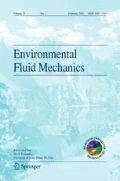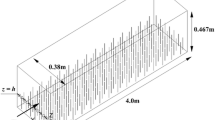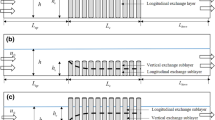Abstract
The paper focuses on the numerical simulation of the exchange flow between open water and floating vegetation, which plays an important role in maintaining the ecological balance by transporting nutrient matter. The simulation was conducted using a new solver developed upon OpenFOAM. A modified RNG k-ε turbulence model, which is expected to model both the high- and low-Reynolds number flows correctly, was used to determine the eddy viscosity. Several particular terms were added into the momentum equations and turbulence model equations to model the effects of vegetation and buoyancy. Among these terms, the term for the effect of vegetation in the ε-equation was re-modelled. The model was validated by properly predicting the profiles of mean velocity and turbulent kinetic energy for flows through suspended canopies. The density flow between open and vegetated water was simulated with the same conditions as those of the experiment conducted by Zhang and Nepf. The predicted results agreed well with the experimental data and provided more detailed information of such exchange flow. The convection between the root layer and the layer beneath the roots, which was not observed in the experiment, was observed in the numerical simulation.






Similar content being viewed by others
References
Ultsch G (1973) The effect of water hyacinth Eichhornia crassipes on the microenvironment of aquatic communities. Arch fur Hydrobiol 72:460–473
Lovstedt C, Bengtsson L (2008) Density-driven current between reed belts and open water in as shallow lake. Water Resour Res 44:W10413
Oldham CE, Sturman JJ (2001) The effect of emergent vegetation of convective flushing in shallow wetlands: scaling and experiment. Limnol Oceanogr 46:1486–1493
Zhang X, Nepf H (2009) Thermally-driven exchange flow between open water and an aquatic canopy. J Fluid Mech 632:227–243
Ho H, Lin Y (2005) Gravity currents over a rigid and emergent vegetated slope. Adv Water Resour 76:72–80
Huai W, Hu Y, Zeng Y, Han J (2012) Velocity distribution for open channel flows with suspended vegetation. Adv Water Resour 49:56–61
Coates M, Ferris J (1994) The radioactively driven natural convection beneath a floating plant layer. Limnol Oceanogr 39:1186–1194
Zhang X, Nepf H (2011) Exchange flow between open water and floating vegetation. Environ Fluid Mech 11:531–546
Ayotte KW, Finnigan JF, Raupach MR (1999) A second-order closure for neutrally stratified vegetation canopy flow. Bound-Layer Meteorol 90:189–216
Pedras MHJ, de Lemos MJS (2001) Microscopic turbulence modelling for incompressible flow through undeformable porous media. Int J Heat Mass Transf 44:1081–1093
Sogachev A, Panverov O (2006) Modification of two-equation models to account for plant drag. Bound-Layer Meteorol 121:229–266
Wang W, Huai W, Gao M (2014) Numerical simulation of flow through vegetated multi-stage compound channel. J. Hydrodyn 26:467–473
Rodi W (1980) Turbulence models and their application in hydraulics. University of Karlsruhe, Karlsruhe
King AT, Tinoco RO, Cowen EA (2012) A k-ε turbulence model based on the scales of vertical shear and stem wakes valid for emergent and submerged vegetated flows. J Fluid Mech 701:1–39
Svensson U, Häggkvisk K (1990) A two-equation turbulence model for canopy flows. J Wind Eng Ind Aerodyn 35:201–211
López F, García MH (2001) Mean flow and turbulence structure of open channel flow through non-emergent vegetation. J Hydraul Eng 127:392–402
Defina A, Bixio AC (2005) Mean flow and turbulence in vegetated open channel flow. Water Resour Res 41:W07006
Green SR (1992) Modelling turbulence air flow in a stand of widely-spaced trees. PHOENICS J Comput Fluid Dyn Appl 5:294–312
Liu J, Chen J, Black T, Novak M (1996) k-ε modelling of turbulent air flow downwind of a model forest edge. Bound-Layer Meteorol 77:21–44
Sanz C (2003) A note on k-ε modelling of vegetation canopy air-flow. Bound-Layer Meteorol 108:191–197
Foudhil H, Brunet Y, Caltagirone JP (2005) A fine-scale k-ε model for atmospheric flow over heterogeneous landscapes. Environ Fluid Mech 5:247–265
Katul GG, Mahrt L, Poggi D, Sanz C (2004) One- and two- equation model for canopy turbulence. Bound-Layer Meteorol 113:81–109
Nepf HM (2012) Flow and transport in regions with aquatic vegetation. Annu Rev Fluid Mech 44:123–142
Liu Z, Chen Y, Zhu D, Jiang C, Hui E (2012) An analytical model for vertical velocity profiles in flows with submerged shrub-like vegetation. Environ Fluid Mech 12:341–346
Ghisalberti M, Nepf HM (2004) The limited growth of vegetated shear layers. Water Resour Res 40:W07502
O’Donncha F, Hartnett M, Plew D (2015) Parameterizing suspended canopy effects in a three-dimensional hydrodynamic model. J Hydraul Res 53:714–727
Yakhot V, Orszag SA (1986) Renormalization group analysis of turbulence. I. Basic theory. J Sci Comput 1(1):3–35
Plew DR (2011) Depth-averaged drag coefficient for modeling flow through suspended canopies. J Hydraul Eng 137:234–247
Raupach MR, Shaw RH (1982) Averaging procedures for flow with vegetation canopies. Bound-Layer Meteorol 22:79–90
Finnigan JJ, Shaw RH (2008) Double-averaging methodology and its application to turbulent flow in and above vegetation canopies. Acta Geophys 56:534–561
Yakhot A, Rakib S, Flannery WS (1994) Low-Reynolds number approximation for turbulent eddy viscosity. J Sci Comput 9:283–292
Koutsourakis N, Bartzis J, Markatos NC (2012) Evaluation of Reynolds stress, k-ε and RNG k-ε turbulence models in street canyon flows using various experimental datasets. Environ Fluid Mech 12:379–403
Markatos NC, Malin MR, Cox G (1982) Mathematical model of buoyancy-induce smoke flow in enclosures. Int J Heat Mass Transf 25:63–75
Tanino Y, Nepf HM (2008) Lateral dispersion in random cylinder arrays at high Reynolds number. J Fluid Mech 600:339–371
Tanino Y, Nepf HM (2008) Laboratory investigation of mean drag in random array of rigid, emergent cylinders. J Hydraul Eng 134:34–41
Fox TA, West GS (1993) Fluid induced loading of cantilevered circular cylinders in a low-turbulence uniform flow. Part 2: fluctuating loads on a cantilever of aspect ratio 30. J Fluids Struct 7:15–28
Duan Y, Liu Z, Chen Y, Zhu D (2016) Improved 2D shallow water model able to capture the effects of complex bathymetric features through their subgrid modeling. Journal of Hydraulic engineering. doi:10.1061/(ASCE)HY.1943-7900.0001246,04016081
Nepf HM, Vivoni ER (2000) Flow structure in depth-limited, vegetation flow. J Geophys Res 105:28547–28557
Pope SB (2000) Turbulent flows. Cambridge University Press, Cambridge
Kara S, Kara M, Stoesser T, Sturm T (2015) Free-surface versus rigid-lid LES computations for bridge-abutment flow. J Hydraul Eng 141:04015019
Naot D, Rodi W (1982) Calculation of secondary currents in channel flows. J Hydraul Div ASCE 110:173–193
Acknowledgments
We acknowledge the financial support of the National Natural Science Foundation of China (No. 51279079 and No. 51323014), National Science and Technology Support Project of China (No. 2015BAB07B09), and Tsinghua University Initiative Scientific Research Program (No. 2014z09112).
Author information
Authors and Affiliations
Corresponding author
Rights and permissions
About this article
Cite this article
Liu, Z., Chen, Y., Wu, Y. et al. Simulation of exchange flow between open water and floating vegetation using a modified RNG k-ε turbulence model. Environ Fluid Mech 17, 355–372 (2017). https://doi.org/10.1007/s10652-016-9489-5
Received:
Accepted:
Published:
Issue Date:
DOI: https://doi.org/10.1007/s10652-016-9489-5




